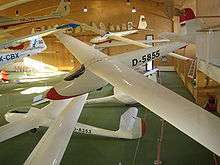Scheibe Zugvogel
| Zugvogel | |
|---|---|
| | |
| Zugvogel IIIA | |
| Role | Glider |
| National origin | West Germany |
| Manufacturer | Scheibe Flugzeugbau |
| Designer | Rudolph Kaiser Egon Scheibe |
| Status | Production completed |
| Number built | 100 |
| Variants | Scheibe SF-27 Zugvogel V |
The Scheibe Zugvogel (English: Migratory bird) is a West German, high-wing, single-seat, FAI Open Class glider that was produced by Scheibe Flugzeugbau. The first version was designed by Rudolph Kaiser and subsequent versions by Egon Scheibe.[1][2][3]
Design and development
The Zugvogel was designed with the goal of a simple and inexpensive, but high performance, open class competition glider, with quick assembly. It was developed through several variants before production ended after 100 had been completed.[1][2]
The aircraft is of mixed construction, with a welded steel tube fuselage covered in doped aircraft fabric covering, wooden framed tail surfaces covered in fabric and wooden wings. The 17.0 m (55.8 ft) span wing uses a NACA 63-616 airfoil at the wing root, changing to a NACA 63-614 section at the wing tip. The wing uses dive brakes for glidepath control. The nose is covered with fibreglass. The landing gear is a fixed monowheel.[1][2][4]
The Zugvogel IIIB was type certified in the United States on 6 May 1964. Zugvogel IIIAs operated in the US are in the Experimental - Racing/Exhibition category.[5][6]
Operational history
US glider pilot Helen Dick set a number of US national feminine single-place records in her Zugvogel IIIB between 1964 and 1967. These included a distance of 492.2 km (305.8 mi), distance to goal of 364.6 km (226.6 mi) and an out and return distance of 400.0 km (248.5 mi).[1][2]
In July 2011 there were three Zugvogel IIIAs and two IIIBs registered with the US Federal Aviation Administration and two Zugvogel IIIAs and four IIIBs registered with the British Civil Aviation Authority.[6][7]
Variants
- Zugvogel I
- Initial version
- Zugvogel II
- Improved version
- Zugvogel III
- Improved version
- Zugvogel IIIA
- 17.0 m (55.8 ft) wingspan, 37.8:1 glide ratio.[1][2]
- Zugvogel IIIB
- Similar to the IIIA, but with a shallower fuselage.[1][2]
- Zugvogel IV
- Zugvogel IVA
- Scheibe SF-27 Zugvogel V
- FAI Standard Class development
- Loravia LCA-10 Topaze
- Loravia LCA-11 Topaze
Aircraft on display

Specifications (Zugvogel IIIA)
Data from Sailplane Directory, Soaring and Type Certificate G4eu[1][2][5][8]
General characteristics
- Crew: one
- Length: 7.1 m (23 ft 4 in)
- Wingspan: 17.0 m (55 ft 9 in)
- Wing area: 14.48 m2 (155.9 sq ft)
- Aspect ratio: 20:1
- Airfoil: root: NACA 632616, mid: NACA 632615, root: NACA 632614
- Empty weight: 243 kg (536 lb)
- Max takeoff weight: 365 kg (805 lb)
Performance
- Stall speed: 58 km/h (36 mph; 31 kn)
- Never exceed speed: 200 km/h (124 mph; 108 kn)
- Rough air speed max: 140 km/h (87.0 mph; 75.6 kn)
- Aerotow speed: 140 km/h (87.0 mph; 75.6 kn)
- Winch launch max speed: 100 km/h (62.1 mph; 54.0 kn)
- Terminal velocity: with full airbrakes 210 km/h (130 mph; 113 kn)
- g limits: +4 -2
- Maximum glide ratio: 35 at 80 km/h (49.7 mph; 43.2 kn)
- Rate of sink: 0.58 m/s (114 ft/min) at 67 km/h (41.6 mph; 36.2 kn)
- Wing loading: 25.2 kg/m2 (5.2 lb/sq ft)
See also
- Related lists
References
- 1 2 3 4 5 6 7 Activate Media (2006). "Zugvogel 3 Scheibe". Retrieved 21 July 2011.
- 1 2 3 4 5 6 7 Said, Bob (November 1983). "1983 Sailplane Directory". Soaring Magazine: 98. ISSN 0037-7503.
- ↑ Simons, Martin, Sailplanes 1945-1965, (Ed: Eqip) p.162
- ↑ Lednicer, David (2010). "The Incomplete Guide to Airfoil Usage". Retrieved 1 July 2011.
- 1 2 Federal Aviation Administration (September 1965). "Type Certificate Data Sheet No. G4EU" (PDF). Retrieved 21 July 2011.
- 1 2 Federal Aviation Administration (July 2011). "Make / Model Inquiry Results". Retrieved 21 July 2011.
- ↑ Civil Aviation Authority (United Kingdom) (July 2011). "GINFO Search Results Summary". Retrieved 21 July 2011.
- ↑ Shenstone, B.S.; K.G. Wilkinson (1958). The World's Sailplanes:Die Segelflugzeuge der Welt:Les Planeurs du Monde (in English, French, and German) (1st ed.). Zurich: Organisation Scientifique et Technique Internationale du Vol a Voile (OSTIV) and Schweizer Aero-Revue. pp. 61–67.
External links
 Media related to Scheibe Zugvogel at Wikimedia Commons
Media related to Scheibe Zugvogel at Wikimedia Commons